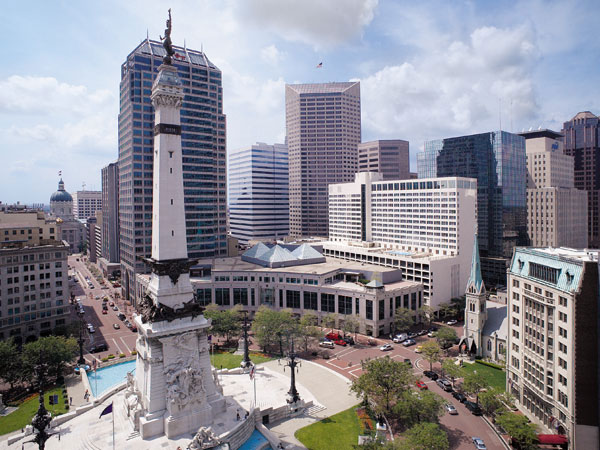Monument Circle: Indianapolis, Indiana

Summary
Since 1821 when Alexander Ralston laid out the state's capital in Indianapolis and located "Circle Street" in the middle of the mile square plat, Monument Circle has served as the literal and figurative center of Indianapolis. The Soldiers and Sailors Monument, designed by Bruno Schmitz of Germany in an international competition, rests at the center of the Circle. Other features include bronze statuary of three former Indiana governors and a general, a grand staircase, and two water pools. There also are striking views of the state capitol building and the city from atop a 231-foot-tall observation tower.
Designated Area
Located in downtown Indianapolis where four streets converge — East and West Market Streets and North and South Meridian Streets.

Monument Circle, located in the heart of Circle City, was planned in 1821. The Indianapolis State Capitol building sits two blocks to the west; the circle itself is surrounded by Victorian-era and Art Deco buildings dating back to 1857. Photo courtesy Indy GIS.
Planning Excellence
The outer perimeter of the space is ringed by a series of large buildings, some dating to 1857, which give the 4.5 acres that make up the Circle, surrounding roadway, and inner and outer sidewalks a strong sense of enclosure.
Architects Preston C. Rubush and Edgar O. Hunter are largely responsible for the unique character of the buildings surrounding the Circle. Their designs for the Art Deco Circle Tower at 55 Monument Circle, the Columbia Club at 121 Monument Circle, and the Circle Theatre at 45 Monument Circle redefined the public space, changing its character from a collection of small, Victorian-era buildings to distinctive 1920s office buildings.
The Circle is a natural gathering place for the city, says Emmis Communications President and CEO Jeff Smulyan. Visitors can find exercise classes and strawberry festivals, and more than 100,000 attend the annual lighting of the Soldiers and Sailors Monument. Monument Circle was the place where residents spontaneously gathered following the Indianapolis Colts' 2007 Super Bowl victory.

The Soldiers and Sailors Monument is centered within the circle. It is flanked by two water pools and a grand staircase, which leads to the base where visitors can enter the monument and view the city from the 231-foot-tall observation tower within. Photo courtesy Harold Miller.
Defining Characteristics, Features
History
- Area inside of Circle Street named "Governor's Circle" in 1827 when the governor's mansion was built — but never occupied — on the parcel surrounded by the Circle
- In 1867, City Council orders the Circle to be graded and benches and sidewalks added; renamed Circle Park
- Soldiers and Sailors Monument, dedicated in 1902, is first such memorial in the nation honoring the common soldier; added to National Register of Historic Places in 1973
- 1922 city ordinance allows buildings on Circle to rise 150 feet provided top 42 feet are stepped back one foot for each three feet in height; step-back principle included in city's first Central Business District Ordinance (1964)
- Monument part of Washington Street-Monument Circle Historic District; added to National Register of Historic Places in 1997
- Indianapolis Monument Circle Idea Competition announced in March 2011; the international juried competition solicits ideas for design, land-use, programming and activities taking place on the space during next 30 years
Unique design
- State Capitol building is located in direct view from Monument Circle from its inception
- Soldiers and Sailors Monument, made from Indiana limestone, is 342 feet in diameter and 284 feet tall; at top is an allegorical statue portraying Victory, nicknamed "Miss Indiana"
- Inside the base of the monument is the Colonel Eli Lilly Civil War Museum, dedicated to the city's fallen servicemen and women
- Monument Circle used as a model for the Indianapolis flag, represented as a white star in the middle of the flag's red circle
- Pools of water on the base of the monument's east and west sides contrast with the grand stairs on the north and south sides
- Four bronze statues honor former Indiana governors William Henry Harrison, James Whitcomb, and Oliver P. Morton, and General George Rogers Clark
- Pedestrians on outer ring are separated from vehicular traffic by raised islands containing trees, light standards, planters, and 25-foot-wide sidewalk; a 23-foot-wide inner walkway surrounds Monument's base
Center of culture, citywide events
- Monument Circle is bordered on each side by a distinct cultural district: the State Capitol building on the west, City Market on the east, North Meridian Street, home to several war memorials on the north, and Circle Centre Mall on the south
- Christ Church Cathedral (125 Monument Circle), is the last of the four churches that were located on the Circle during the mid-19th century; built 1857
- Hilbert Circle Theatre, home to the Indianapolis Symphony Orchestra, is located in the southeast quadrant of the Circle
- Monument Circle events include the 500 Festival Parade that occurs before the Indianapolis 500 auto race over the Memorial Day weekend
- The Circle of Lights is a nearly 50-year-old annual celebration in which 4,700 lights are strung to the top of the Monument; one of country's largest decorative lightings

Monument Circle is a practical yet attractive gathering place for planned events like parades or the annual Soldiers and Sailors Monument Christmas Lighting. Tourists and locals also come to rest and sip coffee on the monument's grand staircase. Photo courtesy Harold Rominger.


